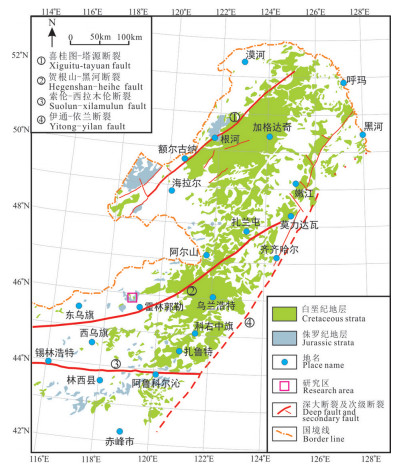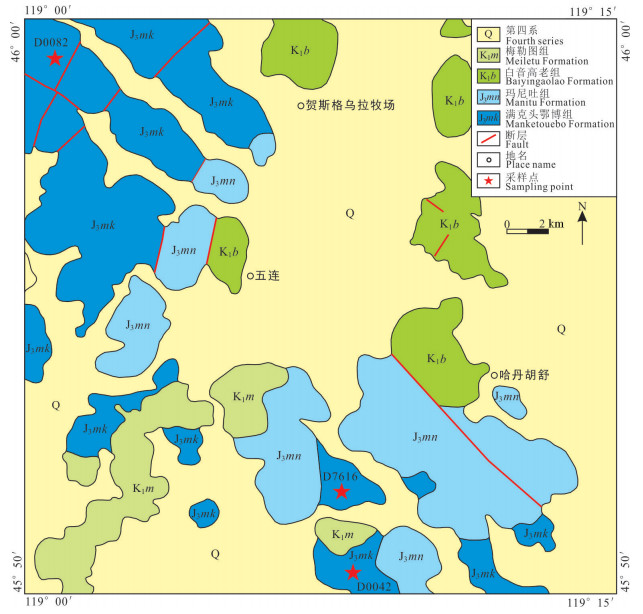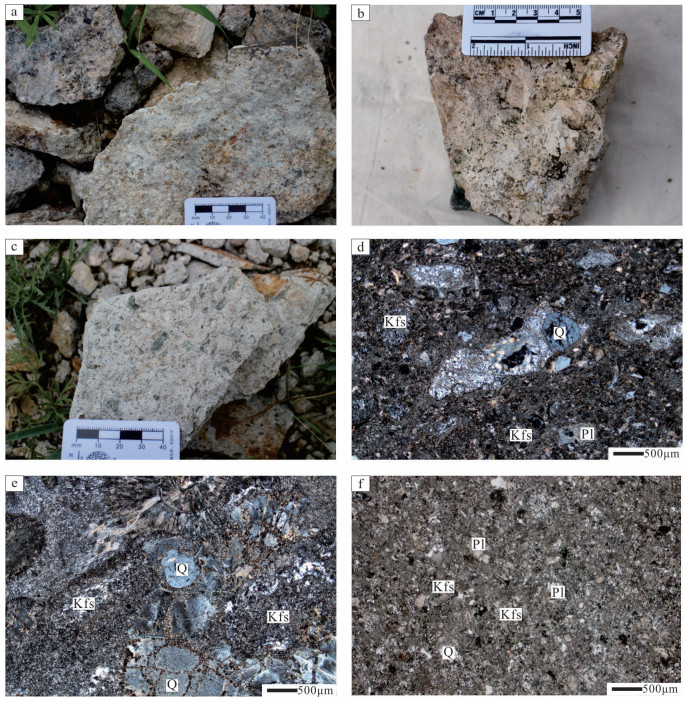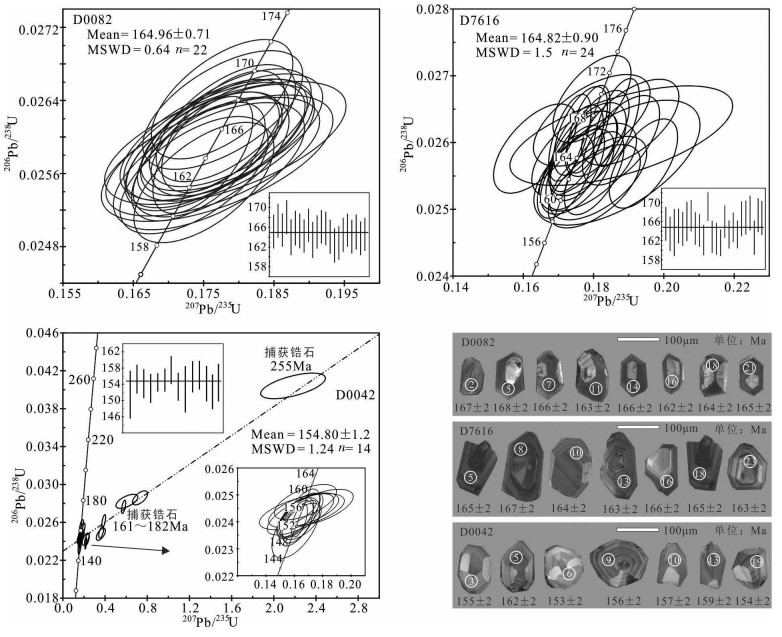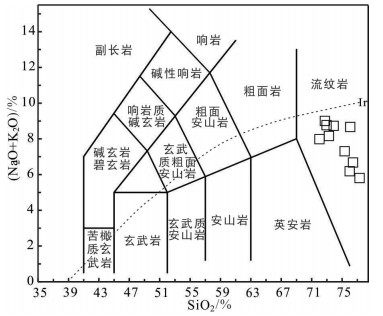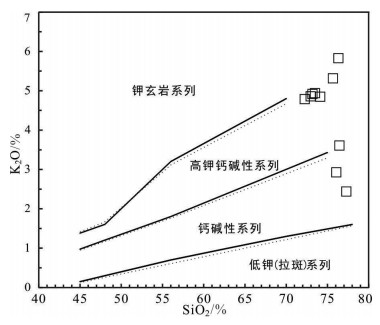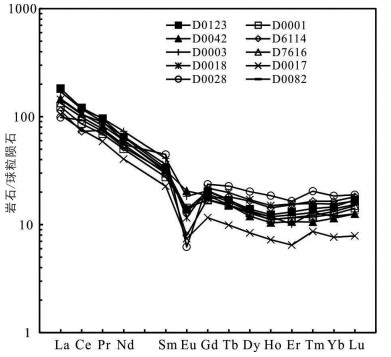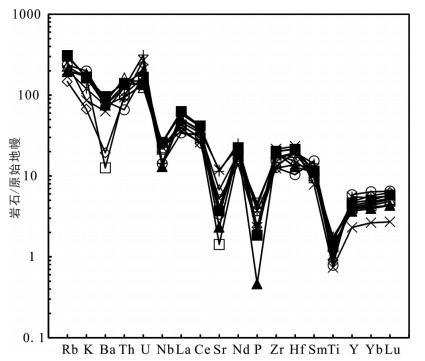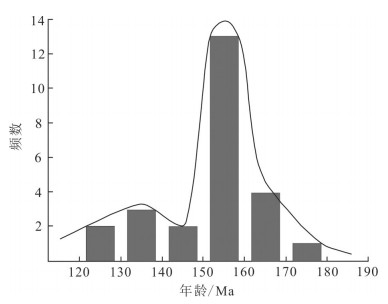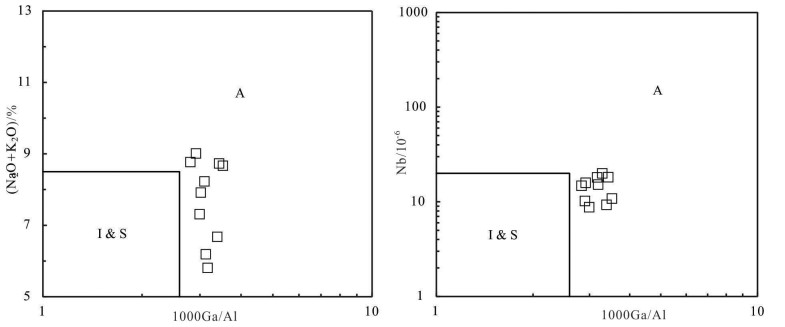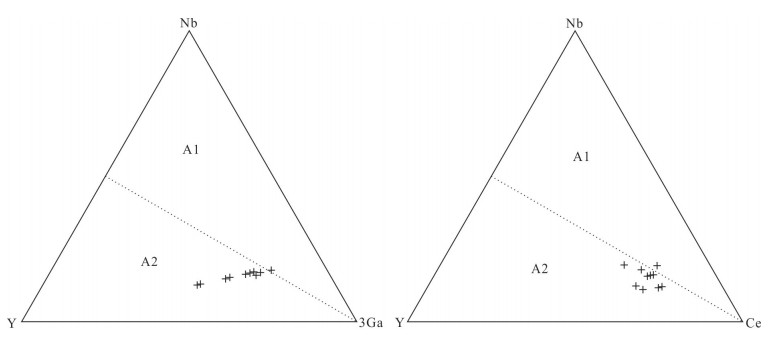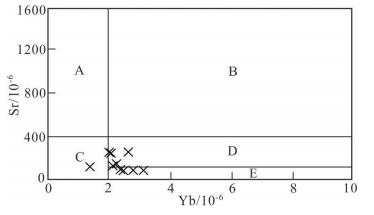Geochronology, geochemistry and tectonic setting of volcanic rocks from Manketouebo Formation in Wulagai area, southern Da Hinggan Mountains
-
摘要:研究目的
通过查明大兴安岭乌拉盖地区火山岩的年龄、地球化学特征,探讨火山岩形成的时代、成因及构造背景,为研究大兴安岭南部地区的岩浆活动和构造演化过程提供依据。
研究方法选取大兴安岭乌拉盖地区满克头鄂博组火山岩,系统开展LA-MC-ICP-MS锆石U-Pb年代学和岩石地球化学研究。
研究结果研究区满克头鄂博组火山岩形成于中—晚侏罗世((154.8 ±1.2)~(164.96±0.71)Ma),火山岩具有高硅、富碱、富钾、贫镁、贫钙的特征,属于高钾钙碱性系列岩石。所有样品的稀土配分曲线具有相似特征,稀土总量中等,轻重稀土分馏明显,属轻稀土富集型,Eu负异常显著。微量元素特征表现为富集大离子亲石元素(LILE)Rb、K、Th、U,亏损高场强元素(HFSE)Nb、Ta、Ti、P,岩石具有低Sr和较高的Yb含量,表现出与A型花岗岩相似的地球化学特征。
结论结合区域地质资料及本文研究成果,认为研究区满克头鄂博组火山岩岩浆来源于地壳岩石的部分熔融,产生于造山后伸展构造背景,其形成可能与蒙古—鄂霍茨克洋闭合后的岩石圈伸展作用有关。
创新点: 研究区满克头鄂博组火山岩形成于中—晚侏罗世,属于高钾钙碱性系列岩石,具有A型花岗岩地球化学特征,形成于蒙古—鄂霍茨克洋闭合导致的伸展构造环境。
Abstract:This paper is the result of geological survey engineering.
ObjectiveBy finding out the age and geochemical characteristics of volcanic rocks in Wulagai area of Da Hinggan Mountains, this paper discusses the age, genesis and tectonic background of volcanic rocks, so as to provide a basis for the study of magmatic activity and tectonic evolution in the south of Da Hinggan Mountains.
MethodsOur project carried out systematically study the LA-MC-ICP-MS zircon U-Pb chronology and rock geochemistry from the volcanic rocks of Manketouebo Formation in Wulagai area of Da Hinggan Mountains.
ResultsThe volcanic rocks of Manketouebo Formation in the study area were formed in the middle Late Jurassic ((154.8±1.2)-(164.96±0.71)Ma). The volcanic rocks of this region belong to alkali series rocks, with characteristics of high silicon, rich in alkali and potassium, low magnesium and calcium. The rare earth distribution curves of all samples have similar characteristics. The total amount of rare earth is medium, the fractionation of light and light rare earth is obvious, which belongs to light rare earth enrichment type, and the negative Eu anomaly is significant. The rocks are relatively enriched in the large ion lithophile elements Rb, K, Th and U, and have a strong deficit in the high-field strong elements such as Nb, Ta, Ti, P; the volcanic rocks have the characteristics of low Sr, high Yb and A-type granite.
ConclusionsThe studies on trace elements and rare earth elements indicate that the volcanic magma are derived from the melting of the crust and have the same magmatic source. The volcanic rocks of Manketouebo Formation originated in the post orogenic extensional tectonic background, which was possibly related to the lithosphere extension after the closure of the Mongol-Okhotsk Ocean.
-
1. 引言
石泉–旬阳金矿带整装勘查区7个图幅区1∶50 000水系沉积物测量始于2013年(图1),其中饶峰幅、迎丰街幅和安康幅1∶50 000水系沉积物测量由中国地质调查局发展研究中心2016—2018年组织实施;铁佛寺幅、汉阴幅、大河口幅和赵家湾幅1∶50 000水系沉积物测量由中国地质调查局西安地质调查中心2013—2015年组织实施,承担单位均为陕西地矿第一地质队有限公司。
陕西石泉–旬阳金矿带整装勘查区位于秦岭造山带中部的南秦岭构造带,在漫长地质历史演化中,该区地层经历了多期变形,构造样式以褶皱、滑脱和韧性剪切带最为典型。地层区划隶属于华南地层大区中的牛山地层小区(韩芳林等,2013)(图2)。因盖层与基底间拆离滑脱,以出露滨海环境下形成的震旦纪—早古生代黑色浅变质强变形细碎屑岩系建造最为典型(张复新等,2009;唐永忠等,2012)。区内出露地层有古元古代杨坪岩组、耀岭河岩组中基性火山岩,古生代沉积—浅变质岩,中晚志留世—早泥盆世沉积地层发育不全(刘国惠和张寿广,1993)。
石泉–旬阳金矿带整装勘查区1∶50 000水系沉积物测量从2013年7月份编写项目设计书开始,各项工作均按相关技术要求执行。项目总体按三个阶段进行,第一阶段组织地球化学勘查技术人员进行1∶50 000水系沉积物测量采样工作;第二阶段检查、核对、整理和处理数据,圈定地球化学异常;第三阶段编制地球化学系列图件,建立完善石泉–旬阳金矿带整装勘查区的区域地球化学数据库,筛选并进行异常查证工作。
陕西石泉–旬阳金矿带整装勘查区水系沉积物测量原始数据集元数据简表见表1。
表 1 数据库(集)元数据简表条目 描述 数据库(集)名称 陕西石泉–旬阳金矿带整装勘查区饶峰幅等7个图幅区1∶50 000水系沉积物测量原始数据集 数据库(集)作者 谈 乐,陕西地矿第一地质队有限公司
张永强,陕西地矿第一地质队有限公司
刘小朋,陕西地矿第一地质队有限公司
李小明,陕西地矿第一地质队有限公司
王才进,陕西地矿第一地质队有限公司数据时间范围 2013—2018年 地理区域 陕西省石泉县–旬阳县地区 数据格式 *.xlsx 数据量 2.01MB 数据服务系统网址 http://dcc.cgs.gov.cn 基金项目 中国地质调查局地质调查项目(121201004000150017-53、121201004000160901-54、121201004000172201-45、12120113048100) 语种 中文 数据库(集)组成 数据集为Excel表格,包括7个独立的工作表(sheet),分别为“饶峰幅采样点位及元素分析结果表”、“铁佛寺幅采样点位及元素分析结果表”、“汉阴幅采样点位及元素分析结果表”、“大河口幅采样点位及元素分析结果表”、“赵家湾幅采样点位及元素分析结果表”、“迎丰街幅采样点位及元素分析结果表”、 “安康幅采样点位及元素分析结果表” 2. 野外工作方法
2.1 方法选择
勘查区属湿润−半湿润中低山丘陵自然景观区(樊会民和李方周,2013),湿润、多雨、强剥蚀、深切割,以物理风化为主,沟系冲、洪积物具粗岩屑性质(刘劲松等,2016),适宜开展水系沉积物测量。根据《地球化学普查规范(1∶50 000)》(DZ/T 0011−2015),结合勘查区地球化学景观特点,确定本次地球化学普查采样介质为水系沉积物,采样密度4~8点/km2,样品粒级选择−20目~+60目。
2.2 样品采集
2.2.1 采样部位
勘查区1∶50 000水系沉积物测量采样部位均选择在河沟底部或河岸与水面接触处(张源等,2018)。在间歇性水流地区或主干河道中,主要在河床底部采样;在水流湍急的河道中选择在水流变缓处、水流停滞处、转石背后、水流由窄变宽处,以及河道转弯内侧有较多细粒物质聚集处采样。
2.2.2 采样物质
采样介质以代表原生地质找矿信息的基岩物质成分为原则,采样物质为水系沉积物中的淤泥、粉砂或细砂。
2.2.3 采样方法
勘查区水系沉积物所采集的样品为粗−细粒级混合的粒级段,有效地避开了腐植层取样,样品采集过程中,加强了对蚀变−矿化强烈或重点找矿地段的加密采样工作。采用的具体技术方法如下:
①采样前,先用采样勺拨去地表浮土或腐植层,再进行取样。
②每次装袋前,首先检查布样袋,看是否有开线或破洞。含水样品装袋时先用塑料袋分装后再装入布样带中,防止袋内水分相互淋滤造成湿样互相污染。
③为了提高样品的代表性,样品采集均在采样点位上下游20~30 m范围内3~5处多点采集,组合成一件样品。
④样品采集避开了矿山开发、村镇、水坝、淤地造田、交通要道和路口造成的污染物及岸边崩塌堆积物地段。
2.2.4 野外定点
陕西石泉–旬阳金矿带整装勘查区涉及1∶50 000图幅共7幅(表2),图幅坐标系采用1980西安坐标系,中央经线为111°,图幅涉及地理数据均在陕西地理信息测绘局购买。
表 2 陕西石泉−旬阳金矿带整装勘查区涉及的7幅1∶50 000地形图图幅名称 图幅号 饶峰幅 I49E17001 迎丰街幅 I49E18002 铁佛寺幅 I49E18003 汉阴幅 I49E19003 大河口幅 I49E19004 赵家湾幅 I49E19005 安康幅 I49E02005 用1∶50 000标准地形图作为水系沉积物测量野外工作手图,采用手持IGS-100掌上机(李超岭等,2002)结合地形图进行野外定点。定点实际距离误差均小于30 m,即在手图上均小于1 mm。
2.3 采样点密度
本次共采集水系沉积物样品13 169件。根据勘查区地形地貌特点、景观条件、地质特征,本次1∶50 000水系沉积物测量分别采用了不同的采样布局和采样密度:加密区(即指1∶200 000化探异常明显、矿化信息相对较多、基岩面积大、第四系分布面积较少的地区,除正常布点外,成矿有利地段适当加密)采样密度为5.18~5.46点/km2;一般工作区(即指第四系分布面积相对较多,基岩出露面积小或零星,1∶200 000化探异常弱的地区)采样密度为:4.1~4.3点/km2;放稀区(即山间盆地)采样密度为3.13~3.52点/km2。该采样密度组合可有效地控制工作区内绝大多数汇水面积,经济实用,可有效地达到地球化学普查的目的。
2.4 样品加工
样品加工基本流程为:自然干燥→揉碎→过筛→混匀→称量缩分→填写标签→装袋→填写送样单→装箱(陈玉明和陈秀法,2018)。
样品干燥方式采取日晒风干。干燥过程中及时揉搓样品,防止结块,并用木槌适当敲打。
② 样品干燥后过−20目~+60目尼龙筛,对筛下样品用对角线折叠法混匀,缩分后装入纸样袋中,其重量均≥310 g。
③按样品缩分法将加工好的样品缩分成两份各≥150 g,一份装牛皮纸袋送检,另一份装塑料瓶封装当副样留存。
3. 样品分析测试方法
样品分析测试工作先后由具备岩矿测试甲级资质的自然资源部西安矿产资源监督检测中心和陕西地矿局汉中地质大队有限公司实验室承担,严格执行《地球化学普查(比例尺1∶50 000)规范样品分析技术的补充规定》。
3.1 实验室样品加工与制备
实验室配备有专职样品管理人员,负责样品的验收和保管,并严格按照规范要求办理样品交接手续。
以50件样品为一个分析批次进行编码和样品加工,每一个分析批次中随机插入4个国家一级标准物质,然后进入计算机,打印出分析号与送样号的对照表,以供样品管理人员在管理样品、填写汇总表等准备工作中使用,样品随后由样品管理人员下达至碎矿间进行无污染碎样。
化探样品在加工前均在60℃以下充分烘干。在大批量样品加工前,先对岩屑样分别进行玛瑙球数量、球磨时间的最佳条件试验,使其细磨后样品粒度满足1∶50 000区域地球化学调查的要求为原则。要求细磨加工后样品粒度达到−0.074 mm(−200目)占90%以上。
样品管理人员对每批样品的加工粒度是否达到规定要求进行检查;检查合格后,按规定插入指定的监控样及国家一级标样,同时依照密码编号分出内检样,随后交由质量管理人员下达分析任务。
3.2 分析项目及分析方法
根据项目任务书、合同书及总体设计要求,2013—2015年度 1∶50 000水系沉积物测量分析项目为:Au、Ag、Cu、Pb、Zn、As、Sb、Hg、V、Mo、Ti、W共12种元素。2016—2018年度1∶50 000水系沉积物测量分析项目为Au、Ag、Cu、Pb、Zn、As、Sb、Hg、Bi、Sn、W、Mo、Cd、Co、Cr、Ni共计16种元素。
采用光栅光谱仪(OES)、原子荧光仪(AFS)、等离子质谱仪法(ICP-MS)、发射光谱法(GF-AAS)等仪器进行分析测试,所有元素报出率均为100%。勘查区18种元素分析测试方法配套方案见表3。
表 3 勘查区18种元素分析方法、检出限及报出率统计表分析方法 元素含量 1∶50 000地球化学测量规定检出限 所用方法检出限 报出率(%) GF-AAS w(Au)/10−9 0.3~1 0.23 100 F-AAS w(Cu)/10−6 2 1.00 100 w(Zn)/10−6 20 5.00 100 HG-AFS w(As)/10−6 0.5~1 0.20 100 w(Sb)/10−6 0.3 0.05 100 CV-AFS w(Hg)/10−9 10~50 2.00 100 w(Bi)/10−6 0.3 0.1 100 ICP-OES w(Ti)/10−6 100 9.3 100 w(V)/10−6 20 5 100 OES w(Ag)/10−6 0.050 0.019 100 w(Sn)/10−6 2 0.5 100 ICP-MS w(Pb)/10−6 5~10 0.91 100 w(W)/10−6 1 0.048 100 w(Mo)/10−6 1 0.056 100 w(Ni)/10−6 1 0.21 100 w(Co)/10−6 1 0.10 100 w(Cr)/10−6 10 1.00 100 w(Cd)/10−6 0.2 0.02 100 4. 数据样本描述
石泉–旬阳金矿带整装勘查区饶峰幅等7个图幅1∶50 000水系沉积物测量原始数据集为Excel表格型数据,包括7个独立的工作表(sheet),分别为“饶峰幅水系沉积物测量采样点位及元素分析结果表”、“迎丰街幅水系沉积物测量采样点位及元素分析结果表”、“铁佛寺幅水系沉积物测量采样点位及元素分析结果表”、“汉阴幅水系沉积物测量采样点位及元素分析结果表”、“大河口幅水系沉积物测量采样点位及元素分析结果表”、“赵家湾幅水系沉积物测量采样点位及元素分析结果表”、“安康幅水系沉积物测量采样点位及元素分析结果表”(宋相龙等,2017)。每个工作表(sheet)包含如下内容:样品编号、高斯坐标、图幅号、地层、分析结果(铁佛寺幅、大河口幅、汉阴幅、赵家湾幅分析元素为Au、Hg、Ag、Cu、Pb、Zn、Mo、As、Sb、Ti、V、W;迎丰街幅、饶峰幅、安康幅分析元素为Au、Ag、Cu、Pb、Zn、As、Sb、Hg、Bi、Sn、W、Mo、Cd、Co、Cr、Ni)、备注。数据结构见表4。
表 4 陕西石泉−旬阳金矿带整装勘查区水系沉积物测量数据结构表序号 数据项名称 量纲 数据类型 字段长度 实例 1 样品编号 − 字符型 20 57C2 2 图幅号 − 字符型 20 I49E018002 3 地层 − 字符型 20 O3-S1b 4 高斯横坐标 − 字符型 20 255460 5 高斯纵坐标 − 字符型 20 3672075 6 经度 − 字符型 20 108°22′45″ 7 纬度 − 字浮型 20 33°08′48″ 8 Au 10−9 浮点型 20 1.03 9 Ag 10−6 浮点型 20 42 10 Cu 10−6 浮点型 20 35.9 11 Pb 10−6 浮点型 20 35.9 12 Zn 10−6 浮点型 20 83.7 13 As 10−6 浮点型 20 3.88 14 Sb 10−6 浮点型 20 2.13 15 Hg 10−9 浮点型 20 49 16 Bi 10−6 浮点型 20 0.85 17 Sn 10−6 浮点型 20 3 18 W 10−6 浮点型 20 2.14 19 Mo 10−6 浮点型 20 0.93 20 Cd 10−6 浮点型 20 0.1 21 Co 10−6 浮点型 20 22.3 22 Cr 10−6 浮点型 20 94.6 23 Ni 10−6 浮点型 20 41.9 24 Ti 10−6 浮点型 20 − 25 V 10−6 浮点型 20 − 5. 数据质量和评估
5.1 原始数据质量
铁佛寺幅、汉阴幅、大河口幅和赵家湾幅地球化学测量样品测试过程中以50件样品为一个分析批次进行编码和样品加工,每一个分析批次中随机插入4个国家一级标准物质,分别为GBW07302a、GBW07304a、GBW07309、GBW07318,对分析过程的精密度进行监控。另外随机分段加入12件国家一级标准物(每500件样品插入一次),共插入15次,对分析过程的准确度进行监控,并对样品中部分高值和低值进行了抽查分析,抽查样品数量比例为2.6%。
饶峰幅、迎丰街幅和安康幅地球化学测量样品测试过程中以50件样品为一个分析批进行编码和样品加工,共分为243批。每一个分析批次中随机插入购买于中国地质科学院地球物理地球化学勘查研究所的4个国家一级标准物质对分析过程的准确度进行监控。其中Au、Ag、Hg、Pb、Sn、As、Sb和Bi共8种元素插入GSD-10、GSD-14、GSD-18、GSD-20控制分析过程精密度;Cr、Co、Ni、Cu、Zn、Mo、Cd和W共8种元素插入GSD-8a、GSD-9、GSD-10、GSD-14控制分析过程精密度,并对样品中部分高值和低值进行了抽查分析,抽查样品数量比例为4.1%。
本次检测工作中,分析元素内检(重复样)合格率均在95.00%以上;元素报出率均达到100%;元素异常复查合格率均为97.5%以上;所选用分析方法的检出限均满足DZ/T0130.4−2006中1∶50 000化探样品标准要求。方法的精密度:对所选一级标准物质检测的△lgC平均值在(−0.099~0.099)以内。方法准确度:对所选一级标准物质检测的△lgC平均值在(−0.099~0.099)以内。所选分析方法的检出限、精密度和准确度均满足《地球化学普查(比例尺1∶50 000)规范样品分析技术的补充规定》的质量要求。
上述质量参数数据表明,本次检测的分析质量完全符合《地球化学普查(比例尺1∶50 000)规范样品分析技术的补充规定》及DZ0130.4−2006的质量要求。
5.2 成果数据库建设质量
陕西石泉–旬阳金矿带整装勘查区饶峰幅等7个图幅区1∶50 000水系沉积物测量成果数据库建设(万常选等,2009)均按照化探数据模型采用DGSS软件平台实现(庞健峰等,2017),样品中各分析元素属性结构均参照中国地质调查局固体矿产勘查数据库内容与结构(左群超等,2018;李超岭等,2013)填写,数据结构内容完整齐全。所形成的7幅1∶50 000水系沉积物测量数据库已由中国地质调查局西安地质调查中心及中国地质调查局发展研究中心专家评审验收,评分93分,评为“优秀级”,已完成相关数据库汇交。
6. 结论
本次数据集工作区范围是由中国地质调查局西安地质调查中心与中国地质调查局发展研究中心组织实施的陕西石泉–旬阳金矿带整装勘查区内饶峰幅等7幅图3 010 km2 1∶50 000水系沉积物测量工作,是陕西石泉–旬阳金矿带整装勘查区内首次系统性的采用统一采样方法、分析测试方法、统一分析元素,也是本整装勘查区内首次规范化建立地球化学数据库,获得了珍贵的第一手地球化学测量资料。
本数据集成果指导在整装勘查区内圈定金找矿靶区10处,金成矿远景区12处❶,其中在圈定的陕西省汉阴县双河口一带金找矿靶区内新发现坝王沟金矿点,通过后期省地勘基金投入,金(333+334)资源量30吨;在圈定的陕西省安康市汉滨区将军山一带金找矿靶区内新发现早阳金矿点,通过后期省地勘基金投入,金(333+334)资源量20吨。另外运用本数据集成果新发现4处金矿点,分别为陕西省宁陕县堰沟金矿点、陕西省安康市汉滨区柳坑金矿点、陕西省石泉县石桥金矿点、陕西省石泉县栈房金矿点,均有一定的找矿潜力。另外,本数据集成果指导我省找到2~4处新的大型金矿产资源开发基地。
注释:
❶张永强, 孙健, 谈乐. 2018. 陕西石泉−旬阳金矿带整装勘查区矿产调查与找矿预测2016—2018年子项目总成果报告[R]. 安康:陕西地矿第一地质队有限公司, 1−260.
1. Introduction
The measurement of 1∶50 000 stream sediments across 7 map sheets of the integrated survey area of the Shiquan-Xunyang gold zone began in 2013 (Fig. 1), of which those in the Raofeng, Yingfengjie and Ankang map sheets were organized by the Development and Research Center of China Geological Survey in 2016—2018; those in the Tiefosi, Hanyin, Dahekou and Zhaojiawan map sheets were organized by the Xi’an Center of China Geological Survey in 2013—2015, and both were conducted by the Team No.1, Shaanxi Bureau of Geology and Mineral Resources Co. Ltd..
The integrated survey area of the Shiquan-Xunyang gold ore zone, Shaanxi, located at the South Qinling tectonic zone in the midst of the Qinling orogeny, has experienced multi-stage deformations in its long history of geological evolution, where the typical tectonic patterns are folding, detachment and ductile shearing zones. In terms of stratigraphic regionalization, it belongs to the Niushan stratigraphic sub-region of the South China stratigraphic super-region (Han FL et al., 2013) (Fig. 2). Due to decoupling detachment between the overlying strata and basement, the outcrop in the area is characterized by the formation of Sinian−early-Paleozoic, black, low-metamorphic, strongly-deformed fine clastic rock series, which were formed in the coastal sea environment (Zhang FX et al., 2009; Tang YZ et al., 2012). The outcropped strata within the area include the Paleoproterozoic Yangpingyan Formation, the basic volcanic rock of the Yaolinghe Formation and Paleozoic sedimentary−low-metamorphic rocks, where mid- and late-Silurian−early-Devonian sedimentary strata are poorly developed (Liu GH and Zhang SG, 1993).
The measurement of the 1∶50 000 stream sediments in the integrated survey area of the Shiquan-Xunyang gold ore zone began with preparation of the project design in July 2013, all works being done in accordance with the relevant technical specifications. The project was completed in three stages: Stage 1, organization of the geochemical staff to take samples for the measurement of the 1∶50 000 stream sediments; Stage 2, checking, verifying, collating and processing data, and delineation of geochemical anomalies; Stage 3, plotting a series of geochemical maps, establishing and improving the regional geochemical database for the integrated survey area of the Shiquan-Xunyang gold ore zone, and screening and verifying anomalies.
Metadata for the measured original dataset of the stream sediments in the 7 map sheets of the integrated survey area of the Shiquan-Xunyang gold ore zone, Shaanxi, are shown in Table 1.
表 1 Metadata Table of Database (Dataset)Items Description Database (dataset) name The 1∶50 000 Original Measurement Dataset on Stream Sediments for 7 Map Sheets including the Raofeng Map in the Integrated Survey Area of the Shiquan-Xunyang Gold Ore Zone, Shaanxi Database (dataset) authors Tan Le, Team No.1, Shaanxi Bureau of Geology and Mineral Resources Co. Ltd.
Zhang Yongqiang, Team No.1, Shaanxi Bureau of Geology and Mineral Resources Co. Ltd.
Liu Xiaopeng, Team No.1, Shaanxi Bureau of Geology and Mineral Resources Co. Ltd.
Li Xiaoming, Team No.1, Shaanxi Bureau of Geology and Mineral Resources Co. Ltd.
Wang Caijin, Team No.1, Shaanxi Bureau of Geology and Mineral Resources Co. Ltd.Data acquision time 2013—2018 Geographic area Shiquan-Xunyang, Shaanxi Data format *.xlsx Data size 2.01MB Data service system URL http://dcc.cgs.gov.cn Fund project China Geological Survey Project (121201004000150017-53, 121201004000160901-54, 121201004000172201-45, 12120113048100). Language Chinese Database(dataset) composition The dataset consists of 7 separate Excel sheets: Raofeng Sampling Points and Element Analytical Result Sheet, Tiefosi Sampling Points and Element Analytical Result Sheet, Hanyin Sampling Points and Element Analytical Result Sheet, Dahekou Sampling Points and Element Analytical Result Sheet, Zhaojiawan Sampling Points and Element Analytical Result Sheet, Yingfengjie Sampling Points and Element Analytical Result Sheet and Ankang Sampling Points and Element Analytical Result Sheet. 2. Field Work Methods
2.1 Selection Method
The survey area is a humid−semihumid mid-and-low hilly natural landscape area (Fan HM and Li FZ, 2013), humid, rainy, strongly denuded, deeply cut, mainly physically-weathered, where channel-system alluvium and diluvium have the properties of coarse debris, suitable for the measurement of the stream sediments (Liu JS et al., 2016). In accordance with the Specifications of the Geochemical Reconnaissance Survey (1∶50 000)(DZ/T 0011−2015), considering the geochemical landscape features of the survey area, it was decided to use stream sediment as the medium to be sampled for this geochemical reconnaissance survey, at a sampling density of 4~8 points/km2, and –20 meshes ~ +60 meshes are selected for the sample’s grain size.
2.2 Sampling
2.2.1 Sample Location
In the survey area, samples for measurement of 1∶50 000 stream sediments are all taken from the river bottom or the contact between the riverbank and the water surface (Zhang Y et al., 2018). In intermittent or trunk river channels, samples are mainly taken from the bottom of the riverbed; in rivers with rapid flow, samples are taken at places where water flows slowly or stops, or behind a boulder, or where water flow widens, or at the inner side of the turn of the river channel, where much more fine-grained materials concentrate.
2.2.2 Sampling Materials
Following the principle that sampled media shall represent material components of bedrocks containing original geological prospecting information, sampling materials are sludge, silt or fine sand in stream sediments.
2.2.3 Sampling Methods
Samples taken from the stream sediments in the survey area are graded sections, mixing coarse−fine-grain sizes, care being taken to avoid sampling from the humus layer. During sampling, an emphasis was placed on taking more samples at places where alteration−mineralization is strong, or which are priorities for prospecting. Samples are taken using the specific technique below:
① Prior to sampling, the topsoil or humus layer is removed with a sampling spoon.
② The cloth bag used for housing samples is checked to ensure that it does not have split seams or broken holes before placing samples within it. Before putting moist samples in the bag, they were placed in a plastic bag and then in the cloth bag, to prevent samples from becoming wet and contaminated, due to mutual leaching.
③ To make samples more representative, samples were taken at multiple points of 3~5 places 20~30 m within upstream and downstream of the sampling points and then combined into one sample.
④ Sampling avoids locations where there are pollutants and accumulated collapses at the bank due to mine development, villages and towns, dams, field-making from silty land, traffic route or road junctions.
2.2.4 Point Fixation in the Field
The integrated survey area of the Shiquan-Xunyang gold ore zone, Shaanxi, involves seven 1∶50 000 map sheets (Table 2) in which the 1980 Xi’an coordinate system is used and the central meridian is 111°, and geological data involved in the map sheets were purchased from the Shaanxi Geographic Information Survey Bureau.
表 2 Topographic map of seven 1∶50 000 Map Sheets involved in the Integrated Survey Area of the Shiquan-Xunyang Gold Ore Zone, ShaanxiMap sheet name Map sheet number Raofeng I49E17001 Yingfengjie I49E18002 Tiefosi I49E18003 Hanyin I49E19003 Dahekou I49E19004 Zhaojiawan I49E19005 Ankang I49E02005 The 1∶50 000 standard topographic map is used as a base map for field measurement of the stream sediments to determine the sampling points in the field with a hand-held IGS-100 device (Li CL et al., 2002). Errors in point localization were less than 30 m from their actual locations, i.e. less than 1 mm on the base map.
2.3 Density of Sampling Points
During the project there were 13 169 samples in total taken from stream sediments. Based on topographic and landform characteristics, landscape conditions and geological features, for the measurement of these 1∶50 000 stream sediments, different sampling layouts and densities were used: at the densest area (i.e. referring to areas where at 1∶200 000 a geochemical anomaly is obvious, there was more information on mineralization, larger in the bedrock area and distributed with less Quaternary strata, and in addition to normal point arrangements, sampling in sections favoring metallogenesis are undertaken to the standard density), the sampling density was 5.18~5.46 points/km2; at the ordinal work area (i.e. referring to areas where there are more Quaternary strata, smaller or sporadic outcropped bedrocks, and the 1∶200 000 geochemical anomaly is weak), the sampling density was 4.1~4.3 points/km2; at the scattered area (i.e. intermountain basin), the sampling density was 3.13~3.52 points/km2. The combination of these sampling densities allows the effective control of the vast majority of water catchment within the area, which is cost-effective and enables the effective meeting of the goal of the geochemical reconnaissance survey.
2.4 Sample Processing
The basic procedure to process samples: natural drying → trituration →sieving →mixing evenly → weighing and splitting samples →fillling in the label → placing samples into bags → completing the sample delivery order → placing sampled bags into boxes (Chen YM and Chen XF, 2018).
Sample drying method: dried under sunlight and air. During drying, rub and knead samples regularly to prevent caking, and use a mallet to strike them properly,
② Dried samples were sieved with a −20~+60 mesh nylon sieve, samples under the sieve are mixed evenly through diagonal folding, split and then put into paper bags, their weight being ≥ 310 g.
③ Samples processed by sample splitting were divided into two parts, each part ≥ 150 g, one put into a kraft paper bag and sent for testing, and the other placed into plastic bottles, which were then sealed and kept as duplicate samples.
3. Sample Analysis and Testing
Samples were analyzed and tested by the Xi’an Center for Mineral Resource Supervision and Testing under the Ministry of Natural Resources and a laboratory of the Hanzhong Geological-Battalion Co., Ltd. under the Shaanxi Bureau of Geology and Mineral Resource, both of which possess Qualification A for rock and mineral testing, in strict accordance with the Additional Rules for Regulating Sample Analysis Technologies of Geochemical Reconnaissance Surveys (Scale: 1∶50 000).
3.1 Processing and Preparation of Lab Samples
Labs are provided with full-time staff to manage samples, receive, inspect and care for samples, as well as handle sample handover procedures strictly in accordance with requirements in the specifications.
The samples were coded and processed as an analytical batch of 50, each analytical batch also containing 4 randomly inserted level-1 national standard substances, the data sent to a computer to print out a comparison table showing the respective numbers of samples analyzed and those delivered, which was then used by sample management staff in tasks such as managing samples and filling in the summary tables, and samples were subsequently sent by the sample management staff to the ore-crushing room where they were crushed without contamination.
Geochemical samples must be fully dried at a temperature below 60℃ prior to processing. Before massive sample processing, debris samples should be tested for the best conditions for agate ball numbers and ball-milling time so that the particle size of the finely-ground samples meets the requirement for the 1∶50 000 regional geochemical survey, that finely-ground samples with particle size reaching –0.074 mm (–200 mesh) accounted for at least 90% of the sample.
The sample management staff checked whether each processed batch of samples met the requirement for particle size; inserted designated control samples and Level-1 national standard samples into acceptable batches as required, whilst separating inner inspection samples based on their codes and numbers, and then delivering them to quality management staff to assign analysis tasks.
3.2 Items Analyzed and Analytical Methods
According to the Project Task, Contract and General Design Specification, in 2013—2015, the items to be analyzed during the measurement of the 1∶50 000 stream sediments were the 12 elements: Au, Ag, Cu, Pb, Zn, As, Sb, Hg, V, Mo, Ti and W. In 2016—2018, the items to be analyzed for measurement of the 1∶50 000 stream sediments totalled 16 elements: Au, Ag, Cu, Pb, Zn, As, Sb, Hg, Bi, Sn, W, Mo, Cd, Co, Cr and Ni.
Instruments such as Optical Emission Spectrometer (OES), Atomic Fluorescence Spectrometer (AFS), Inductive Coupling Plasma-Mass Spectrometer (ICP-MS) and Graphite Furnace-Atomic Absorption Spectrometer (GF-AAS) were used in analysis and testing, and all elements reported percentages were 100%. Schemes for testing and analysis of the 18 elements in the survey area are shown in Table 3.
表 3 Analytical methods, detection limits and report percentages of the 18 elements in the survey areaAnalytical method Element content Specified detection limit for the 1∶50 000 geochemical measurement Detection limit of the method used Report percentage (%) GF-AAS w(Au)/10−9 0.3~1 0.23 100 F-AAS w(Cu)/10−6 2 1.00 100 w(Zn)/10−6 20 5.00 100 HG-AFS w(As)/10−6 0.5~1 0.20 100 w(Sb)/10−6 0.3 0.05 100 CV-AFS w(Hg)/10−9 10~50 2.00 100 w(Bi)/10−6 0.3 0.1 100 ICP-OES w(Ti)/10−6 100 9.3 100 w(V)/10−6 20 5 100 OES w(Ag)/10−6 0.050 0.019 100 w(Sn)/10−6 2 0.5 100 ICP-MS w(Pb)/10−6 5~10 0.91 100 w(W)/10−6 1 0.048 100 w(Mo)/10−6 1 0.056 100 w(Ni)/10−6 1 0.21 100 w(Co)/10−6 1 0.10 100 w(Cr)/10−6 10 1.00 100 w(Cd)/10−6 0.2 0.02 100 4. Description of Data Samples
The measured original dataset on the 1∶50 000 stream sediments in the 7 map sheets of the integrated survey area of the Shiquan-Xunyang gold ore zone contains data in Excel form, including 7 separate sheets: Raofeng Sampling Points and Element Analytical Result Sheet, Tiefosi Sampling Points and Element Analytical Result Sheet, Hanyin Sampling Points and Element Analytical Result Sheet, Dahekou Sampling Points and Element Analytical Result Sheet, Zhaojiawan Sampling Points and Element Analytical Result Sheet, Yingfengjie Sampling Points and Element Analytical Result Sheet, and Ankang Sampling Points and Element Analytical Result Sheet (Song XL et al., 2017). Each sheet contains the following: sample No., Gaussian coordinates, map sheet No., stratigraphy, analyzed result (elements analyzed in Tiefosi, Dahekou, Hanyin and Zhaojiawan map sheets are Au, Hg, Ag, Cu, Pb, Zn, Mo, As, Sb, Ti, V and W; elements analyzed in Yingfengjie, Raofeng and Ankang map sheets are Au, Ag, Cu, Pb, Zn, As, Sb, Hg, Bi, Sn, W, Mo, Cd, Co, Cr and Ni) and remarks. Dataset structure could be seen in Table 4.
表 4 Dataset structure of the measured original data of the stream sediments in the integrated survey area of the Shiquan-Xunyang gold ore zone, ShaanxiNo. Name of data item Dimension Data category Field length Real example 1 Sample No. Character type 20 57C2 2 Map sheet No. Character type 20 I49E018002 3 Stratigraphy Character type 20 O3−S1b 4 Gauss horizontal coordinate Character type 20 255460 5 Gauss vertical coordinate Character type 20 3672075 6 Longitude Character type 20 108°22′45″ 7 Latitude Character type 20 33°08′48″ 8 Au 10−9 Floating-point type 20 1.03 9 Ag 10−6 Floating-point type 20 42 10 Cu 10−6 Floating-point type 20 35.9 11 Pb 10−6 Floating-point type 20 35.9 12 Zn 10−6 Floating-point type 20 83.7 13 As 10−6 Floating-point type 20 3.88 14 Sb 10−6 Floating-point type 20 2.13 15 Hg 10−9 Floating-point type 20 49 16 Bi 10−6 Floating-point type 20 0.85 17 Sn 10−6 Floating-point type 20 3 18 W 10−6 Floating-point type 20 2.14 19 Mo 10−6 Floating-point type 20 0.93 20 Cd 10−6 Floating-point type 20 0.1 21 Co 10−6 Floating-point type 20 22.3 22 Cr 10−6 Floating-point type 20 94.6 23 Ni 10−6 Floating-point type 20 41.9 24 Ti 10−6 Floating-point type 20 25 V 10−6 Floating-point type 20 5. Data Quality and Assessment
5.1 Quality of the Original Data
In the process of analyzing and testing geochemical samples in the Tiefosi, Hanyin, Dahekou and Zhaojiawan map sheets, every 50 samples were grouped to be coded and processed as one analytical batch, each analytical batch being randomly inserted with 4 Level-1 national standard substances which were GBW07302a, GBW07304a, GBW07309 and GBW07318, in order to monitor and control the precision of the analytical process. In addition, 12 Level-1 national standard substances are added randomly in sections (once for every 500 samples) for 15 times in total, to monitor the accuracy of the analytical process, and some high and low values of samples were randomly inspected and analyzed, with 2.6% of samples receiving random inspection.
In the process of analyzing and testing geochemical samples in the Raofeng, Yingfengjie and Ankang map sheets, every 50 samples were grouped to be coded and processed as one analytical batch, 243 batches in total. Each analytical batch is randomly inserted with 4 Level-1 national standard substances purchased from the CAGS Geophysical & Geochemical Exploration Institute, in order to monitor and control the accuracy of the analytical process. Of these, to analyze the 8 elements Au, Ag, Hg, Pb, Sn, As, Sb and Bi, GSD-10, GSD-14, GSD-18 and GSD-20 were inserted to control the precision of the analytical process; to analyze the other 8 elements Cr, Co, Ni, Cu, Zn, Mo, Cd and W, GSD-8a, GSD-9, GSD-10 and GSD-14 were inserted to control the precision of the analytical process, and some high and low values of samples were randomly inspected and analyzed, with 1.4 % of samples receiving random inspection.
During this detection, the qualifying rate of element inner examination (duplicate sample) was more than 95.00%; all elements’ report percentages were 100%; the qualifying rate of element anomaly re-examination was at least 97.5%; the detection limits of analytical methods used all met the standard requirement on 1∶50 000 geochemical samples in DZ/T0130.4−2006. Precision of methods: the mean ΔlgC detected with Level-1 national standard substance was within –0.099~+0.099. Accuracy of methods: the mean ΔlgC detected with Level-1 national standard substance was within –0.099~+0.099. The detection limit, precision and accuracy of the analytical methods selected met the quality-related requirements in the Additional Rules for Regulating Sample Analysis Technologies of Geochemical Reconnaissance Surveys (Scale 1∶50 000).
Above-mentioned figures concerning quality-related parameters indicate that this examination fully complied with the quality-related requirements in the Additional Rules for Regulating Sample Analysis Technologies of Geochemical Reconnaissance Surveys (Scale 1∶50 000) and DZ0130.4−2006.
5.2 Quality in Establishing the Resulting Database
The measured results database of the 1∶50 000 stream sediments in the 7 map sheets including Raofeng on the integrated survey area of the Shiquan-Xunyang gold ore zone, Shaanxi (Wan CX et al., 2009), was set up in accordance with the geochemical data model by using the software platform DGSS (Pang JF et al., 2017), properties and structures of all the elements analysed were completed by referring to the content and structure of the CGS’s solid mineral survey database (Zuo QC et al., 2018; Li CL et al., 2013), to ensure that the data structure and content were complete and sound. The generated measurement databases of 1∶50 000 stream sediments in the 7 map sheets have been reviewed and accepted by the experts from the Xi'an Center of China Geological Survey and the Development and Research Center of China Geological Survey, scoring 93, awarded “Excellence”, and have thus been handed over.
6. Conclusions
The scope of the work area involved in this database was the measurement of the 1∶50 000 stream sediments in the 7 map sheets including Raofeng in the integrated survey area of the Shiquan-Xunyang gold ore zone, Shaanxi, organized and implemented by the Xi'an Center and the Development and Research Center of China Geological Survey, covering 3 010 km2. It is the first time that unified sampling, analytical and testing methods have been used to analyze elements in a systematic way in the integrated survey area of the Shiquan-Xunyang gold ore zone, Shaanxi. It is also the first time that a geochemical databases have been established in a standardized way in the integrated survey area, so as to obtain valuable first-hand geochemical measurement information.
With the results from the database, 10 Au prospecting target areas and 12 Au prospective areas were delineated in the integrated survey area❶, and at the newly-discovered Bawanggou Au deposit from the Au-delineated prospecting target area at and around Shuanghekou, Hanyin County, Shaanxi, with a subsequent provincial fund for geological exploration, it was found that the Au resource (333+334) was 30 tons; in the Au-prospecting target area at and around Jiangjunshan, Ankang city, Shaanxi, the Zaoyang Au deposit was recently found, and a subsequent provincial fund created for geological exploration, the Au (333+334) resource is 20 tons. In addition, 4 new gold ore occurrences were discovered in Shaanxi by using the results from this database, and they are located in Yangou, Ningshan County; Liukeng, Hanbin District, Ankang City; Shiqiao and Zhanfang, Shiquan County, all of which have a certain prospecting potential. Furthermore, the results from the database have guided Shaanxi to find 2–4 new large-scale Au resource development bases.
Notes:
❶ Zhang Yongqiang, Sun Jian, Tan Le. 2018. Comprehensive result report of sub-projects from 2016 to 2018 on mineral investigation and prospecting prediction in the integrated survey area of the Shiquan-Xunyang gold ore zone, Shaanxi[R]. Ankang: Team No.1, Shaanxi Bureau of Geology and Mineral Resources Co.Ltd., Ankang, Shaanxi, 1−260 (in Chinese).
-
图 1 大兴安岭地区中生代火山岩分布图(据许文良等, 2013; 金若时等, 2017修改)
Figure 1. Distribution map of Mesozoic volcanic rocks in the Da Hinggan Mountains (modified from Xu Wenliang et al., 2013; Jin Ruoshi et al., 2017)
图 3 乌拉盖地区火山岩野外及镜下照片
a—流纹岩野外照片;b—流纹质晶屑熔结凝灰岩野外照片;c—流纹质晶屑玻屑凝灰岩野外照片;d—流纹岩镜下照片;e—流纹质晶屑熔结凝灰岩镜下照片;f—流纹质晶屑玻屑凝灰岩镜下照片Q—石英;Pl—斜长石;Kfs—钾长石
Figure 3. Field and microscope photographs of volcanic rocks from Wulagai area
a-Field photographs of rhyolite; b-Field photographs of rhyolite crystallized fume; c-Field photographs of rhyolitic crystal debris vitreoclastic tuff; d-Microscope photographs of rhyolite; e-Microscope photographs of rhyolite crystallized fume; f-Microscope photographs of rhyolitic crystal debris vitreoclastic tuff Q-Quartz; Pl-Plagioclase; Kfs-Potash feldspar
图 7 乌拉盖地区火山岩稀土元素球粒陨石标准化配分模式图(球粒陨石标准化数据引自Sun and McDonough, 1989)
Figure 7. Chondrite-normalized REE patterns for volcanic rocks in Wulagai area(chondrite value after Sun and McDonough, 1989)
图 9 大兴安岭地区满克头鄂博组年龄分布图(据李鹏川等,2016修改)
Figure 9. Distribution diagram of Manketouebo Formation ages in Da Hinggan Mountains area (after Li Pengchuan et al., 2016)
图 10 乌拉盖地区火山岩(Na2O+K2O)和Nb对1000Ga/Al图解(底图据Whalen et al., 1987)
A—A型花岗岩类; I & S—I、S型花岗岩类
Figure 10. (Na2O+K2O) and Nb versus 1000Ga/Al diagrams for volcanic rocks in Wulagai area (after Whalen et al., 1987)
A-A-type granitoids; I & S-I & S type granitoids
图 12 乌拉盖地区火山岩Sr-Yb分类图解(据张旗等, 2008)
A—高Sr低Yb型花岗岩;B—高Sr高Yb型花岗岩;C—低Sr低Yb型花岗岩;D—低Sr高Yb型花岗岩;E—非常低Sr高Yb型花岗岩
Figure 12. Sr vs. Yb diagram for volcanic rocks in Wulagai area (after Zhang Qi et al., 2008)
A—High Sr and low Yb granites; B—High Sr and Yb granites; C—Low Sr and Yb granites; D—Low Sr and high Yb granites; E—Lowest Sr and high Yb granites
表 1 乌拉盖地区火山岩锆石LA-MC-ICP-MS U-Pb同位素分析结果
Table 1 Zircon LA-MC-ICP-MS U-Pb dating results of volcanic rocks in Wulagai area

表 2 乌拉盖地区满克头鄂博组火山岩地球化学分析结果(主量元素:%;稀土、微量元素:10-6)
Table 2 Geochemical data of volcanic rocks from Manketouebo Formation in Wulagai area (Major elements: %; Trace elements: 10-6)

-
Bea F, Arzamastsev A, Montero P, Arzamastsev L. 2001. Anomalous alkaline rocks of Soustov, Kola: Evidence of mantle-derived metasomatic fluids affecting crustal materials[J]. Contributions to Mineralogy and Petrology, 140(5): 554-556. doi: 10.1007/s004100000211
Belousova E A, Griffin W L, O'Reilly S Y, Fisher N I. 2002. Igneous zircon: Trace element composition as an indicator of source rock type[J]. Contributions to Mineralogy and Petrology, 143: 602-622. doi: 10.1007/s00410-002-0364-7
Chen Yingfu, Wang Genhou, Duan Bingxin. 2012. Zircon SHRIMP geochronology and geochemistry of Late Jurassic volcanic rocks in Huiyin Obo area of Dong Ujimqin Banner, Inner Mongolia[J]. Geology in China, 39(6): 1690-1699(in Chinese with English abstract).
Chen Zhiguang, Zhang Lianchang, Zhou Xinhua, Wan Bo, Ying Jifeng, Wang Fei. 2006. Geochronology and geochemical characteristics of Mesozoic volcanic rocks section in Manzhouli Xinyouqi, Inner-Mongolia[J]. Acta Petrologica Sinica, 22(12): 2972-2986(in Chinese with English abstract).
Cheng Yinhang, Liu Yongshun, Teng Xuejian, Yang Junquan, Li Yanfeng, Peng Lina. 2013. Geochronology, geochemistry and geological significance of Medial-Late Jurassic volcanic rocks in Mohe' ertu area, Inner Mongolia[J]. Acta Geologica Sinica, 87(7): 943-956(in Chinese with English abstract).
Cheng Yinhang, Teng Xuejian, Li Yanfeng, Yang Junquan, Peng Lina, Li Ying. 2014. Geochronology, geochemistry and geological significance of felsic volcanic rocks in Haimosaige area, Inner Mongolia[J]. Acta Petrologica et Mineralogica, 33(2): 211-225(in Chinese with English abstract).
Du Yang, Liu Zhenghong, Cui Weilong, Wang Shijie, Wang Yang, Du Chuanye. 2017. Formation age and geochemical characteristics of volcanic rocks from Manketouebo Formation in Keyihe area, Da Higgan Moutains and its tectonic implications[J]. Global Geology, 36(1): 54-65(in Chinese with English abstract).
Eby G N. 1990. The A-type granitoids: A revies of their occurrence and chemical characteristics and speculations on their ptrogenesis[J]. Lithos, 26: 115-134. doi: 10.1016/0024-4937(90)90043-Z
Fan Weiming, Guo Feng, Wang Yuejun, Lin Ge. 2003. Late Mesozoic calcalkaline volcanism of post-orogenic extension in the northern Da Hinggan Mountains, northeastern China[J]. Journal of Volcanology and Geothermal Research, 121(1-2): 115-135. doi: 10.1016/S0377-0273(02)00415-8
Gao Xiaofeng, Guo Feng, Fan Weiming, Li Chaowen, Li Xiaoyong. 2005. Origin of late Mesozoic intermediate-felsic volcanic rocks from the northern Da Hinggan Mountain, NE China[J]. Acta Petrologica Sinica, 21(3): 737-748(in Chinese with English abstract).
Gou Jun, Sun Deyou, Zhao Zhonghua, Ren Yunsheng, Zhang Xunyuan, Fu Changliang, Wang Xi, Wei Hongyan. 2010. Zircon LA-ICP-MS U-Pb dating and petrogenesis of rhyolites in Baiyingaolao Formation from the southern Manzhouli, Inner-Mongolia[J]. Acta Petrologica Sinica, 26(1): 333-344(in Chinese with English abstract).
Green T H. 1994. Experimental studies of trace-element partitioning applicable to igneous petrogenesis-Sedona 16 years later[J]. Chemical Geology, 117(1-4): 1-36. doi: 10.1016/0009-2541(94)90119-8
Han Baofu. 2007. Diverse post-collisional granitoids and their tectonic setting discrimination[J]. Earth Science Frontiers, 14(3): 64-72(in Chinese with English abstract).
Hirose K. 1997. Melting experiments on lherzolite KLB-1 under hydrous conditions and generation of high-magnesian andesitic melts[M]. Geology, 25(1): 42-44.
Jahn B M, Wu F Y, Chen B. 2000. Grantitoids of the central Asian orogenic belt and continental growth in the Phanerozoic. Transactions of the Royal Society of Edinburgh[J]. Earth Sciences, 91(1/2): 181-193.
Jiang Sihong, Zhang Lili, Liu Yifei, Liu Chunhua, Kang Huan, Wang Fengxiang. 2018. Metallogeny of Xing-Meng Orogenic Belt and some related problems[J]. Mineral Deposits, 37(4): 671-711(in Chinese with English abstract).
Jin Ruoshi, Liu Yongshun, Zhang Yuelong, Zhang Kuo, He Peng, Chen Xingshi, Zhang Feng. 2017. The discovery of the Changtuxili Mn-Ag-Pb-Zn polymetallic deposit in the Middle-southern Segment of Da Hinggan Mountains and its significance[J]. Geological Bulletin of China, 36(7): 1268-1275(in Chinese with English abstract).
Kelty T, Yin A, Dash B, Gehrels G E, Ribeiro A E. 2008. Detritalzircon geochronology of Paleozoic sedimentary rocks in the Hangay-Hentey basin, north-central Mongolia: Implications for the tectonic evolution of the Mongol-Okhotsk Ocean in central Asia[J]. Tectonophysics, 451(1/4): 290-311.
Kimura G, Takahashi M, Kono M. 1990. Mesozoic collision~extrusion tectonics in eastern Asia[J]. Tectonophysics, 181(1/4): 15-23.
Li Huaikun, Zhu Shixing, Xiang Zhenqun, Su Wenbo, Lu Songnian, Zhou Hongying, Geng Jianzhen, Li Sheng, Yang Fengjie. 2010. Zircon U-Pb dating on tuff bed from Gaoyuzhuang Formation in Yanqing, Beijing: Further constraints on the new subdivision of the Mesoproterozoic stratigraphy in the Northern North China[J]. Acta Petrologica Sinica, 26(7): 2131-2140(in Chinese with English abstract).
Li Jinyi, Mo Shenguo, He Zhengjun, Sun Guihua, Chen Wen. 2004. The timing of crustal sinistral strike-slip movement in the northern Great Khing'an ranges and its constraint on reconstruction of the crustal tectonic evolution of NE China and adjacent areas since the Mesozoic[J]. Earth Science Frontiers, 11(3): 157-168(in Chinese with English abstract).
Li Pengchuan, Li Shichao, Liu Zhenghong, Li Gang, Bai Xinhui, Wan Le. 2016. Formation age and environment of the volcanic rocks from the Manketouebo Formation in Linxi area, Inner Mongolia[J]. Global Geology, 35(1): 77-88(in Chinese with English abstract).
Li Yinglei, Xu Guo, Liu Huichuan, Bai Lingqi, Su Yinchun, Liu Xiaonv. 2017. Petrogenesis and tectonic implication of volcanic rocks from Manitu Formation in the western great Xing'an Range[J]. Geoscience, 31(4): 683-696(in Chinese with English abstract).
Lin Qiang, Ge Wenchun, Cao Lin, Sun Deyou, Lin Jingguo. 2003 Geochemistry of Mesozoic volcanic rocks in Da Hinggan Ling: the bimodal volcanic rocks[J]. Geochimica, 32(3): 208-222(in Chinese with English abstract).
Liu Kai, Wu Taotao, Liu Jinlong, Bao Qingzhong, Du Shouying. 2018. Geochronology and geochemistry of volcanic rocks in Manketou'ebo Formation of Tulihe area, northern Da Hinggan Mountains[J]. Geology in China, 45(2): 367-376(in Chinese with English abstract).
Liu Jianming, Zhang Rui, Zhang Qingzhou. 2004. The regional metallogeny of Dahingganling, China[J]. Earth Science Frontiers, 11(1): 269-277(in Chinese with English abstract).
Liu Junjie, Ju Wenxin, Zhao Jiufeng, Zhang Haiping, Liu Yongzheng, Yin Jiancheng. 2006. Discussion on the characteristic and structural environmental of the Late Jurassic volcanic rock in Genhe terrain, Daxinganling[J]. Geology and Mineral Resources of South China, 1: 38-46(in Chinese with English abstract).
Liu Zhe, Xue Huaimin, Cao Guangyue. 2017. Zircon U-Pb geochronology, intraplate extensional environment and genesis of Mesozoic volcanic rocks in Zhenglan Banner area, Inner Mongolia, china[J]. Geology in China, 44(1): 151-176(in Chinese with English abstract).
Ma Yongfei, Liu Yongjiang, A. Yu. Peskov, Wang Yan, Song Weimin, Zhang Yujin, Qian Cheng, Liu Tongjun. 2022. Paleozoic tectonic evolution of the eastern Central Asian Orogenic Belt in NE China[J]. China Geology. doi: 10.31035/cg2021079.
Maruyama S, Send T. 1986. Orogeny and relative plate motions: Example of the Japanese Islands[J]. Tectonophysics, 127(3-4): 305-329. doi: 10.1016/0040-1951(86)90067-3
Meng En, Xu Wenliang, Yang Debin, Qiu Kunfeng, Li Changhua, Zhu Hongtao. 2011. Zircon U -Pb chronology, geochemistry of Mesozoic volcanic rocks from the Lingquan basin in Manzhouli area, and its tectonic implications[J]. Acta Petrologica Sinica, 27(4): 1209-1226(in Chinese with English abstract).
Meng Qingren. 2003. What drove late Mesozoic extension of the northern China-Mongolia tract[J]. Tectonophysics, 369: 155-174. doi: 10.1016/S0040-1951(03)00195-1
Metelkin D V, Vernikovsky V A, Kazansky A Y, Wingate T D. 2010. Late Mesozoic tectonics of Central Asia based on paleomagnetic evidence[J]. Gondwana Research, 18(2/3): 400-419.
Ouyang Hegen, Wu Xinli, Mao Jingwen, Su Huiming, Santosh M, Zhou Zhenhua, Chao Li. 2014. The nature and timing of ore formation in the Budunhua copper deposit, southern Great Xing'an Range: Evidence from geology, fluid inclusions, and U-Pb and Re-Os geochronology[J]. Ore Geology Reviews, 63(s2): 238-251.
Rudnick R L, Gao S. 2003. Composition of the Continental Crust[M]// Rudnick R L(ed. ). The Crust, Elsevier-Pergamon, Oxford, 1-64.
Sengör AMC, Natal'in B A, Burtman V S. 1993. Evolution of the Altaid tectonic collage and Paleozoic crustal growth in Eurasia[J]. Nature, 364(6435): 299-307. doi: 10.1038/364299a0
Shan Qiang, Zeng Qiaosong, Luo Yong, Yang Wubin, Zhang Hong, Qiu Yuzhuo, Yu Xueyuan. 2011. SHRIMP U-Pb ages and petrology studies on the potassic and podic rhyolites in Altai, North Xinjiang[J]. Acta Petrologica Sinica, 27(12): 3653-3665.
She Hongquan, Li Jinwen, Xiang Anping, Guan Jidong, Yang Xuncheng, Zhang Dequan, Tan Gang, Zhang Bin. 2013. U-Pb ages of the zircons from primary rocks in middle-northern Daxinganling and its implications to geotectonic evolution[J]. Acta Petrologica Sinica, 28(2): 571-594(in Chinese with English abstract).
Si Qiuliang, Cui tianri, Tang Zheng, Li Wei, Wu Xinwei, Jiang Bin. 2015. Chronology, geochemistry and petrogenesis of the volcanic rocks in Manitu Formation in Chaihe area, central Great Xing'an Range[J]. Journal of Jilin University: Earth Science Edition, 45(2): 389-403(in Chinese with English abstract). http://en.cnki.com.cn/Article_en/CJFDTOTAL-CCDZ201502005.htm
Sun Deyou, Gou Jun, Ren Yunsheng, Fu Changliang, Wang Xi, Liu Xiaoming. 2001. Zircon U -Pb dating and study on geochemistry of volcanic rocks in Manitu Formation from southern Manchuria, Inner Mongolia[J]. Acta Petrologica Sinica, 27(10): 3083-3094(in Chinese with English abstract).
Sun Deyou, Wu Fuyuan, Gao Shan, Lu Xiaoping. 2005. Confirmation of two episodes of A-type granite emplacement during Late Triassic and Early Jurassic in the central Jilin Province, and their constraints on the structural pattern of Eastern Jilin-Heilongjiang Area, China[J]. Earth Science Frontiers, 12(2): 263-275(in Chinese with English abstract).
Sun S S, McDonough W F. 1989. Chemical and isotopic systematics of oceanic basalts: Implications for mantle composition and process[C]//Sauders A D, Norry M J. Magmatism in the Ocean Basins. Geological Society Special Publication, 42(1): 313-345.
Tan Haoyuan, He Zhonghua, Chen Fei, Du Yuedan, Ren Zihui. 2007. Zircon U-Pb ages and geochemical characteristics of volcanic rocks in Baiyingaolao Formation of Suolun area within central Da Hinggan Mountains and their tectonic implications[J]. Geological Bulletin of China, 36(5): 893-908(in Chinese with English abstract).
Tischendorf, Paelchen W. 1985. Zur Klassifikation von Granitoiden. Classification of granitoids[J]. Zeitschrift fuer Geologische Wissenschaften, 13(5): 615-627.
Tomurtogoo O, Windley B F, Kroner A, Badarch G, Liu D Y. 2005. Zircon age and occurrence of the adaatsag ophiolite and muron shear zone, central mongolia: Constraints on the evolution of the mongol-okhotsk ocean, suture and orogen[J]. Journal of the Geological Society, 162(1), 197-229.
Wang Fei, Zhou Xinhua, Zhang Lianchang, Ying Jifeng, Zhang Yutao, Wu Fuyuan. 2006a. Late Mesozoic volcanism in the Great Xing' an Range(NE China): Timing and implications for the dynamic setting of NE Asia[J]. Earth and Planetary Science Letters, 251(1-2): 179-198. doi: 10.1016/j.epsl.2006.09.007
Wang Jinfang, Li Yingjie, Li Hongyang, Dong Peipei. 2018. Formation age of the Delehada Early Cretaceous A-type granite in Xiwu Banner, Inner Mongolia: Evidence from zircon U-Pb chronology[J]. Geology in China, 45(1): 197-198(in Chinese with English abstract).
Wang Pujun, Chen Fukun, Chen Shuming. 2006b. Geochemical and Nd-Sr-Pb isotopic composition of Mesozoic volcanic rocks in the Songliao basin, NE China[J]. Geochemical Journal, 40: 149-159. doi: 10.2343/geochemj.40.149
Wang Tao, Guo Lei, Zhang Lei, Yang Qidi, Zhang Jianjun, Tong Ying, Ye Ke. 2015. Timing and evolution of Jurassic-Cretaceous granitoid magmatisms in the Mongol-Okhotsk belt and adjacent areas, NE Asia: Implications for transition from contractional crustal thickening to extensional thinning and geodynamic settings[J]. Journal of Asian Earth Sciences, 97(Part B, 1): 365-392.
Whalen J B, Currie K L, Chappell B W. 1987. A-type granites: Geochemical characteristics, discrimination and petrogenesis[J]. Contrib. Mineral. Petrol., 95(4): 407-419. doi: 10.1007/BF00402202
Wilson M. 1989. Igneous Petrogenesis[M]. London: Unwin Hyman Press, 295-323.
Wu Fuyuan, Lin Jingqian, Wilde S A, Zhang Xiaoou and Yang Jinhui. 2005. Nature and significance of the Early Cretaceous giant igneous event in Eastern China[J]. Earth and Planetary Science Letters, 233(1/2): 103-119.
Wu Fuyuan, Sun Deyou, Ge Wenchun, Zhang Yanbin, Grant M L, Wilde S A, Jahn B M. 2011. Geochronology of the phanerozoic granitoids in northeastern China[J]. Journal of Asian Earth Sciences, 41(1): 1-30. doi: 10.1016/j.jseaes.2010.11.014
Wu Fuyuan, Sun Deyou, Zhang Guangliang. 2000. Deep Geodynamics of Yanshan Movement. Geological Journal of China Universities, 6(3): 379-388(in Chinese with English abstract).
Wu Yueyong, Jiang Haijiao, Kou Shuai. 2016. Geochemical characteristics of Early Cretaceous volcanic rocks in Qagan Obo area, SonidLeft Banner, Inner Mongolia[J]. Geological Survey and Research, 39(1): 1-14, 23(in Chinese with English abstract).
Xiao Wenjiao, Windley B F, Hao Jie, Zhai Mingguo. 2003. Accretion leading to collision and the Permian solonker suture, Inner Mongolia, China: Termination of the Central Asian Orogenic Belt[J]. Tectonic, 22: 1484-1505.
Xu Meijun, Xu Wenliang, Meng En, Wang Feng. 2011. LA-ICP-MS zircon U-Pb chronology and geochemistry of Mesozoic volcanic rocks from the Shanghulin -Xiangyang Basin in Erguna area, northeastern Inner Mongolia[J]. Geological Bulletin of China, 30 (9): 1321-1338(in Chinese with English abstract).
Xu Wenliang, Ji Weiqiang, Pei Fuping, Meng En, Yu Yang, Yang Debin, Zhang Xingzhou. 2009. Triassic volcanism in eastern Heilongjiang and Jilin provinces, NE China: Chronology, geochemistry, and tectonic implications[J]. Journal of Asian Earth Sciences, 34(3): 392-402. doi: 10.1016/j.jseaes.2008.07.001
Xu Wenliang, Ge Wenchun, Pei Fuping, Meng En, Yu Yang, Yang Debin. 2008. Geochronological framework and tectonic significance of Mesozoic volcanism in northeastern China[J]. Bulletin of Mineralogy, Petrology and Geochemistry, 27(3): 286-287(in Chinese with English abstract).
Xu Wenliang, Wang Feng, PeiFuping, Meng En, Tang Jie, Xu Meijun. 2013. Mesozoic tectonic regimes and regional ore-forming background in NE China: constraints from spatial and temporal variations of Mesozoic volcanic rock associations[J]. Acta Petrologica Sinica, 29 (2): 339-353(in Chinese with English abstract).
Yang Yang, Gao Fuhong, Chen Jingsheng, Zhou Yi, Zhang Jian, Jin Xin. 2012. Zircon U-Pb ages of Mesozoic volcanic rocks in Chifeng area[J]. Journal of Jilin University: Earth Science Edition, 42(2): 257-268(in Chinese with English abstract).
Ying Jifeng, Zhou Xinhua, Zhang Lianchang, Wang Fei. 2010. Geochronological frame work of Mesozoic volcanic rocks in the Great Xing'an Range, NE China, and their geodynamic implications[J]. Journal of Asian Earth Sciences, 39(6): 786-793. doi: 10.1016/j.jseaes.2010.04.035
Zeng Qingdong, Liu Jianming, Yu Cchangming, Ye Jie, Liu Hongtao. 2011. Metal deposits in the Da Hinggan Mountains, NE China: Styles, characteristics and exploration potential[J]. International Geology Review, 53(7): 846-878. doi: 10.1080/00206810903211492
Zhai Degao, Liu Jiajun, Wang Jianping, Yang Yongqiang, Zhang Hongyu, Wang Xxilong, Zhang Qibin, Wang Gongwen, Liu Zhenjiang. 2014. Zircon U-Pb and molybdenite Re-Os geochronology, and whole-rock geochemistry of the Hashitu molybdenum deposit and host granitoids, Inner Mongolia, NE China[J]. Journal of Asian Earth Sciences, 79(2): 144-160.
Zhang Chao, Yang Weihong, He Zhonghua, Wu Hao, Wu Qing. 2014 Chronology and geochemistry of rhyolites in Manketouebo Formation from Taerqi area, southern-central Greater Xingan Range[J]. Global Geology, 33(2): 255-265(in Chinese with English abstract).
Zhang F Q, Chen H L, Yu X, Dong C W, Yang S F, Pang Y M, Batt G E. 2011. Early Cretaceous volcanism in the northern Songliao Basin, NE China, and its geodynamic implication[J]. Gondwana Research, 19(1): 163-176. doi: 10.1016/j.gr.2010.03.011
Zhang Jiheng, Ge Wenchun, Wu Fuyuan, Wilde S. A, Yang Jinhui, Liu Xiaoming. . 2008. Large-scale Early Cretaceous volcanic events in the northern Great Xing'an Range, Northeastern China[J]. Lithos, 102(1-2): 138-157. doi: 10.1016/j.lithos.2007.08.011
Zhang Jiheng. 2009. Geochronology and geochemistry of the Mesozoic volcanic rocks in the Great Xing'an Range, northeastern China: Ph. D dissertation. Beijing: China University of Geosciences(in Chinese with English abstract).
Zhang Jiongfei, Pang Qingbang, Zhu Qun, Jin Chengzhu. 2003. Mengentaolegai Ag-Pb-Zn deposit in Inner Mongolia: Ar-Ar age of muscovite and its significance[J]. Mineral Deposits, 22(3): 253-256(in Chinese with English abstract).
Zhang Lianchang, Zhou Xinhua, Ying Jifeng, Wang Fei, Guo Feng, Wan Bo, Chen Zhiguang. 2008. Geochemistry and Sr-Nd-Pb-Hf isotopes of Early Cretaceous basalts from the Great Xinggan Range, NE China: Implications for their origin and mantle source characteristics[J]. Chemical Geology, 256(1/2): 12-23. http://www.sciencedirect.com/science/article/pii/S0009254108002787
Zhang Letong, Li Shichao, Zhao Qingying, Li Xuefei, Wang Lu, Li Zihao. 2015. Formation age and geochemical characteristics of volcanic rocks from Baiyingaolao Formation of middle Da Hinggan Mountains[J]. Global Geology, 34(1): 44-54(in Chinese with English abstract).
Zhang Lianchang, Chen Zhiguang, Zhou Xinhua, Ying Jifeng, Wang Fei, Zhang Yutao. 2007. Characteristics of deep sources and tectonic-magmatic evolution of the Early Cretaceous volcanics in Genhe area, Da-Hinggan Mountains: constraints of Sr-Nd-Pb-Hf isotopic geochemistries[J]. Acta Petrologica Sinica, 23(11): 2823-2835(in Chinese with English abstract).
Zhang Qi, Wang Yuanlong, Jin Weijun, Jia Xiuqin, Li Chengdong. 2008. Pre-, syn-, and post orogenic granitic rocks recognition[J]. Geological Bulletin of China, 27(1) : 1-18(in Chinese with English abstract).
Zhang Qi, Ran gao, Li Chengdong. 2012. A-type granite: What is the essence? [J]. Acta Petrologica et Mineralogica, 31(4): 621-626(in Chinese with English abstract).
Zhang Xuebin, Zhou Changhong, Lai Lin, Xu Cui, Tian Ying, Chen Lizhen, Wei Min. 2015. Geochemistry and zircon U-Pb dating of volcanic rocks in eastern Xilin Hot, Inner Mongolia and their geological implications[J]. Geology and Exploration, 51(2): 290-302(in Chinese with English abstract).
Zhang Yutao, Zhang Lianchang, Ying Jifeng, Zhou Xinhua, Wang Fei, Hou Quanlin, Liu Qing. 2007. Geochemistry and source characteristics of early Cretaceous volcanic rocks in Tahe, north Da Hinggan Moutain [J]. Acta Petrologica Sinica, 23(11): 2811-2822(in Chinese with English abstract).
Zhao Shuyue, Han Yandong, Zhu Chunyan, Guo Kuicheng, Wang Jianmin, Liu Baoshan. 2004. Geochemical characteristics and geological significance of intermediate and intermediate-acid volcanic rocks in the northern sector of the Da Hinggan volcanic eruption zone[J]. Journal of Geomechanics, 10(3): 276-287(in Chinese with English abstract).
Zhao Zhonghua, Sun Deyou, Gou Jun, Ren Yunsheng, Fu Changliang, Zhang Xueyuan. 2011. Chronology and geochemistry of volcanic rocks in Tamulangou Formation from southern Manchuria, Inner Mongolia[J]. Journal of Jilin University: Earth Science Edition, 41(6): 1865-1880(in Chinese with English abstract).
Zhou Xinhua, Ying Jifeng, Zhang Lianchang, Zhang Yutao. 2009. The petrogenesis of Late Mesozoic volcanic rock and the contributions from ancient micro-continents: constraints from the zircon U-Pb dating and Sr-Nd-Pb-Hf isotopic systematicsv[J]. Earth Science (Journal of China University of Geosciences), 34(1): 1-10(in Chinese with English abstract). doi: 10.3799/dqkx.2009.001
Zhong Mishan, Wang Zhongjiang, Ao Guang, Zhai Furong, Wang Fenli, Wang Qi, Tan Chao, YangYunlai. 2017. Zircon U-Pb chronology and geochemical characteristics of the volcanic rocks of Erlanghe formation in Zhangguangcai range[J]. Geological Survey and Research, 40(3): 161-168, 177(in Chinese with English abstract).
陈英富, 王根厚, 段炳鑫. 2012. 内蒙古东乌珠穆沁旗辉音敖包一带晚侏罗世火山岩特征及时代[J]. 中国地质, 39(6): 1690-1699. doi: 10.3969/j.issn.1000-3657.2012.06.017 陈志广, 张连昌, 周新华, 万博, 英基丰, 王非. 2006. 满洲里新右旗火山岩剖面年代学和地球化学特征[J]. 岩石学报, 22(12): 2971-2986. https://www.cnki.com.cn/Article/CJFDTOTAL-YSXB200612013.htm 程银行, 刘永顺, 滕学建, 杨俊泉, 李艳锋, 彭丽娜. 2013. 内蒙古莫合尔图中—晚侏罗世火山岩年代学、地球化学研究及其意义[J]. 地质学报, 87(7): 943-956. doi: 10.3969/j.issn.0001-5717.2013.07.004 程银行, 滕学建, 李艳锋, 杨俊泉, 彭丽娜, 李影. 2014. 内蒙古海莫赛格酸性火山岩锆石U-Pb年龄、地球化学特征及其意义[J]. 岩石矿物学杂志, 33(2): 211-225. doi: 10.3969/j.issn.1000-6524.2014.02.001 杜洋, 刘正宏, 崔维龙, 王师捷, 王阳, 杜传业. 2017. 大兴安岭克一河地区满克头鄂博组火山岩形成时代、地球化学特征及地质意义[J]. 世界地质, 36(1): 54-65. doi: 10.3969/j.issn.1004-5589.2017.01.005 高晓峰, 郭锋, 范蔚茗, 李超文, 李晓勇. 2005. 南兴安岭晚中生代中酸性火山岩的岩石成因[J]. 岩石学报, 21(3): 737-748. https://www.cnki.com.cn/Article/CJFDTOTAL-YSXB200503015.htm 苟军, 孙德有, 赵忠华, 任云生, 张学元, 付长亮, 王晰, 魏红艳. 2010. 满洲里南部白音高老组流纹岩锆石U-Pb定年及岩石成因[J]. 岩石学报, 26(1): 333-344. https://www.cnki.com.cn/Article/CJFDTOTAL-YSXB201001038.htm 韩宝福. 2007. 后碰撞花岗岩类的多样性及其构造环境判别的复杂性[J]. 地学前缘, 14(3): 64-72. doi: 10.3321/j.issn:1005-2321.2007.03.006 江思宏, 张莉莉, 刘翼飞, 刘春花, 康欢, 王丰翔. 2018. 兴蒙造山带成矿规律及若干科学问题[J]. 矿床地质, 37(4): 671-711. https://www.cnki.com.cn/Article/CJFDTOTAL-KCDZ201804001.htm 金若时, 刘永顺, 张跃龙, 张阔, 何鹏, 陈行时, 张峰. 2017. 大兴安岭中南段昌图锡力锰、银、铅、锌多金属矿床的发现及其意义[J]. 地质通报, 36(7): 1268-1275. doi: 10.3969/j.issn.1671-2552.2017.07.016 李怀坤, 朱士兴, 相振群, 苏文博, 陆松年, 周红英, 耿建珍, 李生, 杨锋杰. 2010. 北京延庆高于庄组凝灰岩的锆石U-Pb定年研究及其对华北北部中元古界划分新方案的进一步约束[J]. 岩石学报, 26(7): 2131-2140. https://www.cnki.com.cn/Article/CJFDTOTAL-YSXB201007016.htm 李锦轶, 莫申国, 和政军, 孙桂华, 陈文. 2004. 大兴安岭北段地壳左行走滑运动的时代及其对中国东北及邻区中生代以来地壳构造演化重建的制约[J]. 地学前缘, 11(3): 157-168. doi: 10.3321/j.issn:1005-2321.2004.03.017 李鹏川, 李世超, 刘正宏, 李刚, 白新会, 万乐. 2016. 内蒙古林西地区满克头鄂博组火山岩形成时代及构造环境[J]. 世界地质, 35(1): 77-88. doi: 10.3969/j.issn.1004-5589.2016.01.008 李英雷, 徐国, 刘汇川, 白灵麒, 苏银春, 刘小女. 2017. 大兴安岭西缘玛尼吐组火山岩成因及构造指示[J]. 现代地质, 31(4): 683-696. doi: 10.3969/j.issn.1000-8527.2017.04.004 林强, 葛文春, 曹林, 孙德有, 林经国. 2003. 大兴安岭中生代双峰式火山岩的地球化学特征[J]. 地球化学, 32(3): 208-222. doi: 10.3321/j.issn:0379-1726.2003.03.002 刘建明, 张锐, 张庆洲. 2004. 大兴安岭地区的区域成矿特征[J]. 地学前缘, 11(1): 269-277. doi: 10.3321/j.issn:1005-2321.2004.01.024 刘俊杰, 鞠文信, 赵九峰, 张海平, 柳永正, 殷建成. 2006. 大兴安岭根河岩区晚侏罗世火山岩特征及构造环境探讨[J]. 华南地质与矿产, 1: 38-46. doi: 10.3969/j.issn.1007-3701.2006.01.007 刘凯, 吴涛涛, 刘金龙, 鲍庆中, 杜守营. 2018. 大兴安岭北段图里河地区满克头鄂博组火山岩年代学及地球化学[J]. 中国地质, 45(2): 367-376. http://geochina.cgs.gov.cn/geochina/ch/reader/view_abstract.aspx?file_no=20180211&flag=1 刘哲, 薛怀民, 曹光跃. 2017. 内蒙古正蓝旗地区中生代火山岩锆石U-Pb年龄与板内伸展环境成因讨论[J]. 中国地质, 44(1): 151-176. http://geochina.cgs.gov.cn/geochina/ch/reader/view_abstract.aspx?file_no=20170111&flag=1 孟恩, 许文良, 杨德彬, 邱昆峰, 李长华, 祝洪涛. 2011. 满洲里地区灵泉盆地中生代火山岩的锆石U-Pb年代学、地球化学及其地质意义[J]. 岩石学报, 27(4): 1209-1226. https://www.cnki.com.cn/Article/CJFDTOTAL-YSXB201104029.htm 欧阳荷根, 李睿华, 周振华. 2016. 内蒙古双尖子山银多金属矿床侏罗纪成矿的年代学证据及其找矿意义[J]. 地质学报, 90(8): 1835-1845. doi: 10.3969/j.issn.0001-5717.2016.08.013 单强, 曾乔松, 罗勇, 杨武斌, 张红, 裘瑜卓, 于学元. 2011. 新疆阿尔泰康布铁堡组钾质和钠质流纹岩的成因及同位素年代学研究[J]. 岩石学报, 27(12): 3653-3665. https://www.cnki.com.cn/Article/CJFDTOTAL-YSXB201112013.htm 佘宏全, 李进文, 向安平, 关继东, 杨郧城, 张德全, 谭刚, 张斌. 2012. 大兴安岭中北段原岩锆石U-Pb测年及其与区域构造演化关系[J]. 岩石学报, 28(2): 571-594. https://www.cnki.com.cn/Article/CJFDTOTAL-YSXB201202019.htm 司秋亮, 崔天日, 唐振, 李伟, 吴新伟, 江斌. 2015. 大兴安岭中段柴河地区玛尼吐组火山岩年代学、地球化学及岩石成因[J]. 吉林大学学报(地球科学版), 45(2): 389-403. https://www.cnki.com.cn/Article/CJFDTOTAL-CCDZ201502005.htm 孙德有, 苟军, 任云生, 付长亮, 王晰, 柳小明. 2011. 满洲里南部玛尼吐组火山岩锆石U-Pb年龄与地球化学研究[J]. 岩石学报, 27(10): 3083-3094. https://www.cnki.com.cn/Article/CJFDTOTAL-YSXB201110024.htm 孙德有, 吴福元, 高山, 路孝平. 2005. 吉林中部晚三叠世和早侏罗世两期铝质A型花岗岩的厘定及对吉黑东部构造格局的制约[J]. 地学前缘, 12(2): 263-275. doi: 10.3321/j.issn:1005-2321.2005.02.028 谭皓元, 和钟铧, 陈飞, 杜岳丹, 任子慧. 2017. 大兴安岭中段索伦地区白音高老组火山岩锆石U-Pb年龄、地球化学特征及构造意义[J]. 地质通报, 36(5): 893-908. doi: 10.3969/j.issn.1671-2552.2017.05.021 王金芳, 李英杰, 李红阳, 董培培. 2018. 内蒙古西乌旗德勒哈达早白垩世A型花岗岩形成时代: 锆石U-Pb定年证据[J]. 中国地质, 45(1): 197-198. http://geochina.cgs.gov.cn/geochina/ch/reader/view_abstract.aspx?file_no=20180118&flag=1 吴福元, 孙德有, 张广良. 2000. 论燕山运动的深部地球动力学本质[J]. 高校地质学报, 6(3): 379-388. doi: 10.3969/j.issn.1006-7493.2000.03.002 武跃勇, 姜海蛟, 寇帅. 2016. 内蒙古苏尼特左旗查干敖包地区早白垩世火山岩地质及地球化学特征[J]. 地质调查与研究, 39(1): 1-14, 23. 徐美君, 许文良, 孟恩, 王枫. 2011. 内蒙古东北部额尔古纳地区上护林向阳盆地中生代火山岩LA-MC-ICP-MS锆石U-Pb年龄和地球化学特征[J]. 地质通报, 30(9): 1321-1338. doi: 10.3969/j.issn.1671-2552.2011.09.001 许文良, 葛文春, 裴福萍, 孟恩, 于洋, 杨德彬. 2008. 东北地区中生代火山作用的年代学格架及其构造意义[J]. 矿物岩石地球化学通报, 27(3): 286-287. 许文良, 王枫, 裴福萍, 孟恩, 唐杰, 徐美君. 2013. 中国东北中生代构造体制与区域成矿背景: 来自中生代火山岩组合时空变化的制约[J]. 岩石学报, 29(2): 339-353. https://www.cnki.com.cn/Article/CJFDTOTAL-YSXB201302002.htm 杨扬, 高福红, 陈井胜, 周漪, 张健, 金鑫. 2012. 赤峰地区中生代火山岩锆石U-Pb年代学证据[J]. 吉林大学学报(地球科学版)(s2), 257-268. https://www.cnki.com.cn/Article/CJFDTOTAL-CCDZ2012S2029.htm 张超, 杨伟红, 和钟铧, 吴浩, 吴庆. 2014. 大兴安岭中南段塔尔气地区满克头鄂博组流纹岩年代学和地球化学研究[J]. 世界地质, 33(2): 255-265. doi: 10.3969/j.issn.1004-5589.2014.02.002 张吉衡. 2009. 大兴安岭中生代火山岩年代学及地球化学研究[D]. 北京: 中国地质大学. 张炯飞, 庞庆邦, 朱群, 金成洙. 2003. 内蒙古孟恩陶勒盖银铅锌矿床白云母Ar-Ar年龄及其意义[J]. 矿床地质, 22(3): 253-256. doi: 10.3969/j.issn.0258-7106.2003.03.005 张乐彤, 李世超, 赵庆英, 李雪菲, 王璐, 李子昊. 2015. 大兴安岭中段白音高老组火山岩的形成时代及地球化学特征[J]. 世界地质, 34(1): 44-54. doi: 10.3969/j.issn.1004-5589.2015.01.006 张连昌, 陈志广, 周新华, 英基丰, 王非, 张玉涛. 2007. 大兴安岭根河地区早白垩世火山岩深部源区与构造-岩浆演化: Sr-Nd-Pb-Hf同位素地球化学制约[J]. 岩石学报, 23(11): 2823-2835. doi: 10.3969/j.issn.1000-0569.2007.11.013 张旗, 王元龙, 金惟俊, 贾秀勤, 李承东. 2008. 造山前、造山和造山后花岗岩的识别[J]. 地质通报, 27(1): 1-18. doi: 10.3969/j.issn.1671-2552.2008.01.001 张旗, 冉皞, 李承东. 2012. A型花岗岩的实质是什么? [J]. 岩石矿物学杂志, 31(4): 621-626. doi: 10.3969/j.issn.1000-6524.2012.04.014 张学斌, 周长红, 来林, 徐翠, 田颖, 陈丽贞. 2015. 锡林浩特东部早白垩世白音高老组岩石地球化学特征、LA-MC-ICP-MS锆石U-Pb年龄及地质意义[J]. 地质与勘探, 51(2): 290-302. https://www.cnki.com.cn/Article/CJFDTOTAL-DZKT201502010.htm 张玉涛, 张连昌, 英基丰, 周新华, 王非, 侯泉林, 刘庆. 2007. 大兴安岭北段塔河地区早白垩世火山岩地球化学及源区特征[J]. 岩石学报, 23(11): 2811-2822. doi: 10.3969/j.issn.1000-0569.2007.11.012 赵书跃, 韩彦东, 朱春燕, 郭奎城, 王建民, 刘宝山. 2004. 大兴安岭火山喷发带北段中性、中酸性火山岩地球化学特征及其地质意义[J]. 地质力学报, 10(3): 276-287. https://www.cnki.com.cn/Article/CJFDTOTAL-DZLX200403009.htm 赵忠华, 孙德有, 苟军, 任云生, 付长亮, 张学元. 2011. 满洲里南部塔木兰沟组火山岩年代学与学与地球化学[J]. 吉林大学学报: 地球科学版, 41(6): 1865-1880. https://www.cnki.com.cn/Article/CJFDTOTAL-CCDZ201106017.htm 周新华, 英基丰, 张连昌, 张玉涛. 2009. 大兴安岭晚中生代火山岩成因与古老地块物质贡献: 锆石U-Pb年龄及多元同位素制约[J]. 地球科学(中国地质大学学报), 34 (1): 1-10. https://www.cnki.com.cn/Article/CJFDTOTAL-DQKX200901002.htm 仲米山, 王忠江, 敖光, 翟富荣, 王粉丽, 王岐, 谭超, 杨运来. 2017. 张广才岭二浪河组火山岩的锆石U-Pb年代学及地球化学特征[J]. 地质调查与研究, 40(3): 161-168, 177. doi: 10.3969/j.issn.1672-4135.2017.03.001 -
期刊类型引用(6)
1. 韩双宝,周殷竹,郑焰,周金龙,李长青,韩强强,李甫成. 银川平原地下水化学成因机制与组分来源解析. 环境科学. 2024(08): 4577-4588 .  百度学术
百度学术
2. 张卓,郭华明,韩双宝,牛笑童. 沉积物中砷的赋存特征及对地下水砷富集的控制:以内蒙古河套盆地为例. 中国地质. 2024(04): 1331-1341 .  本站查看
本站查看
3. 吴光伟,李浩林,王庆兵,顾莎,郭梓烽,刘中业. 鲁西北平原地下水高氟与高碘成因分析. 岩矿测试. 2023(04): 793-808 .  百度学术
百度学术
4. 张卓,柳富田,陈社明. 氢氧、锶钙和锂硼同位素在高氟地下水研究中的应用. 华北地质. 2023(03): 49-56 .  百度学术
百度学术
5. 李红超,单强,马丙太,赵德刚. 基于逻辑回归分析的焦化行业地下水有机污染物分布特征及影响因素研究. 华北地质. 2023(04): 47-54 .  百度学术
百度学术
6. 邢世平,郭华明,吴萍,胡学达,赵振,袁有靖. 化隆—循化盆地不同类型含水层组高氟地下水的分布及形成过程. 地学前缘. 2022(03): 115-128 .  百度学术
百度学术
其他类型引用(2)




 下载:
下载:



